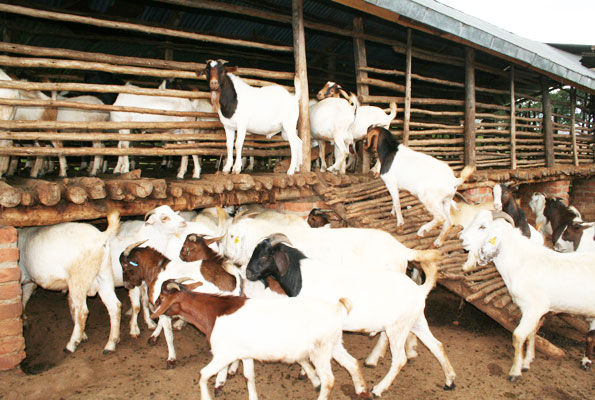- Empty cart.
- Continue Shopping
Dairy Goat Farming

Goat’s milk is rarely consumed in Uganda due to limited knowledge on the vast nutritious benefits found in the milk. Milk from goats is high in calcium, has fewer allergenic proteins, causes less inflammation and is low in cholesterol. It is good for children who are lactose-intolerant .The types of goats that are good for dairy farming are Nubians, Lamanchas, Alpines, Toggenburgs and Saanens. Goats with X-bowed hind legs will provide more milk than the cross-bowed legs goats.
NB: Although goat’s milk is nutritious, it is not advisable to be given to babies before 6 months and regular use between 6 and 12 months is not recommended.
Feeding
• In order to have healthy breeds and a stable supply of Milk, feed the goats with enough proteins, minerals and Vitamins.
• Also feed them with Rice hay which is good for increasing milk production.
Advantages of Goat’s Milk
• Goat’s milk is naturally homogenized (Standardized) unlike cow’s milk which is chemically homogenized (Standardized).
• It contains more calcium and phosphate which is good for bones and blood production.
• Contains more tryptophan, an acid that gives the consumer a feeling of calm, relaxation and sleepiness.
• Goat’s milk is a complete protein containing all the essential amino acids with low fat content.
Analysis of compositions in Goat’s and Cow’s Milk
Composition Goat Cow
Protein (%) (3.1) ( 3.2)
Fat (%) ( 3.5) (3.9)
Calorie/100ml (60) ( 66)
Vitamin A (39) ( 21)
Vitamin B1 (68) ( 45)
Vitamin C (2) ( 2)
Vitamin D (0.7) (0.7)
Calcium (0.19) (0.18)
Iron % (0.07) ( 0.07)
Cholesterol (10) ( 14)
Some of the diseases that affect Goats
Worms
Goats are extremely vulnerable to worms and will actually die if a successful worming program is not in place.
Symptoms
• Weight Loss
• Poor appetite or no appetite
• Diarrhea
• Anemia
• A drop in Milk production or a reduction of growth in early stages
• Pot belly
Control
Buy worm treatments from licensed Veterinary Pharmacies and drug shops
Milk Fever
This is caused by lack of calcium in the body especially after kidding (It shows after kidding because the animal losses a lot of calcium in the milk.
Signs and Symptoms
They are in 3 stages
Stage 1; the goat is mobile with;
• Hypersensitivity
• Restlessness
• Tremors
• Ear twitching
• Head bobbing
• inappetence
• If not managed, it progresses to the second stage
Stage 2;
• The goat can no longer stand
• Weakened heart contraction
• It appears dull
• Dried muzzles
• Cold extremities
• Lower body temperature
• Smooth muscle paralysis which can cause bloat, inability to defecate or urinate
• Goats often tuck their heads in their flanks
Stage 3;
• Lateral recumbence (Lying on the side)
• Unresponsiveness to stimuli like piercing (inflicting pain)
• Unconsciousness
• Coma
Prevention
• Increase calcium levels in the diet especially in the last month of gestation (the gestation period of 150 days months). However in the last two weeks of the fifth month, withdraw the external calcium sources to let the body mobilize its own calcium after delivery.
• Administer dextrose or glucose fluid therapy intravenously (IV), and after give calcium borogluconates (calciject) IV to the recumbent goat. The animal will immediately urinate and stand in the next 5-15minutes.NB: contact a veterinary doctor to give the treatment.
Although a sensitization campaign to teach the public the advantages of goat’s milk is still not in place, farmers who have taken the initiative and ventured into dairy goat farming are milking profits from the business.
NB: The government of Uganda is uplifting local farmers as its contribution through Uganda Industrial Research institute therefore many commercial dairy goat farmers have resorted to the institute for pasteurization of the milk they distribute to shops and supermarkets. This pasteurized milk lasts for a month.
